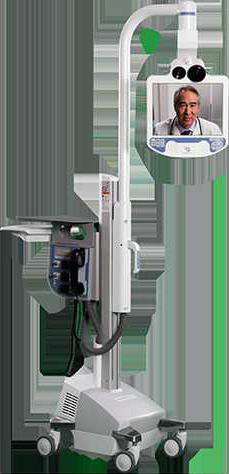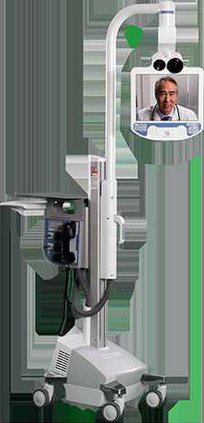HOISINGTON – In a continuation of providing cutting-edge healthcare, Clara Barton Hospital is introducing an addition to its Telemedicine program. In partnership with Wesley Medical Center’s WesleyCare Telemedicine Network (WCTN), Clara Barton is offering stroke-neurology services to patients, by way of a TeleStroke “robot”.
“The robot is another first for Clara Barton, allowing us to be the leading stroke-ready hospital in the area,” said Debra Brockel, PA. “We can save lives by offering this technology that allows us to consult with experts in stroke-specific care.”
The robot allows the medical care providers at Clara Barton to request a stroke-trained neurologist through WCTN to remote in on a monitor in response to a suspected stroke victim. The neurologist is able to see, hear, participate, and provide comprehensive, real-time patient assessment and help develop an individualized treatment plan.
“Clara Barton Hospital and staff are excited to offer this innovative and potentially life-saving service to our patients in and around Barton County,” said Curt Colson, Clara Barton CEO. “Through the partnership with WesleyCare Telemedicine Network, the TeleStroke technology provides our medical staff and patients with virtually immediate access to consultations with neurologists and other healthcare specialists. This program will only further enhance the continuity and level of care we provide to our patients.”
The telemedicine robot utilizes a mobile cart with a monitor, high-resolution camera, and a microphone to simultaneously transmit audio and video. Our radiology department is able to push x-ray images to the remote physicians to be used for diagnosis and the development of a treatment plan.
“The telemedicine network offers immediate and effective high-speed stroke expertise to patients and hospitals that otherwise would not have the resources to receive stroke care within the critical time frame for advanced stroke intervention,” said Dr. Calvin Olmstead, stroke medical director for Wesley Medical Center.
Clara Barton is designated as an Emergent Stroke Ready Hospital, allowing providers to diagnose, treat, and/or transport acute stroke patients to a higher level of care as warranted. In 2012, Clara Barton treated 26 patients that had suffered a stroke. Using WCTN and the robot, 58% of those stroke victims could have stayed in Hoisington, rather than being stabilized and transported elsewhere. Through the robot, with the neurologist, Clara Barton’s medical staff can diagnose and treat stroke victims immediately. The faster a stroke victim receives care, the better to reduce the damage caused by a stroke. By adding this technology, patients will be able to stay close to home and still receive expert and prompt care.
Clara Barton’s designation as a Skilled Swing Bed Facility also allows for patients to receive care closer to home. The Therapy Services department has a role in patient recovery at home, providing physical, occupational, and speech therapy service to in- and out-patients.
The robot began work on Dec. 16 and Clara Barton is currently holding a contest to name it. Entries must be submitted on an official entry form (found at www.clarabatonhospital.com) by Jan. 6, 2014 to qualify. The winning name will be announced and a robot meet-and-greet and open house will be held, in conjunction with the Hoisington Chamber Coffee, from 9:30-11:30, on Jan. 9, 2014.
Clara Barton Hospital is a Critical Access Hospital and Skilled Swing Bed Facility, located in Hoisington, Ks. While operating on the cutting edge of medical technology, Clara Barton provides diagnostic and treatment services to patients in and around Barton County through Clara Barton Hospital, Clara Barton Medical Clinic, Russell Family Medical Care, Clara Barton Surgical Services, Clara Barton Specialty Outreach Clinic, and Clara Barton Surgical Services-Orthopedics.
Break out
Recognizing a stroke
A stroke occurs when a clot blocks blood flow to the brain or when an artery in the brain ruptures, resulting in uncontrolled bleeding. Brain cells critically depend on a consistent flow of oxygen and glucose rich blood. When this flow is interrupted by a stroke, brain cells begin to die. Because our body cannot replicate nerve cells, strokes can lead to permanent brain damage and disability. The negative effects of stroke depend upon which part of the brain the stroke occurs in.
Symptoms include sudden numbness or weakness of the face, arm, or leg, especially on one side of the body, sudden confusion, trouble speaking or understanding, sudden vision changes, sudden trouble walking, dizziness, loss of balance or coordination, sudden, severe headache with no known cause.
Remember to act F.A.S.T.
F – Face drooping; ask the person to smile.
A – Arm weakness; ask the person to raise both arms.
S – Speech difficulty; ask the person to repeat a simple sentence.
T – Time; if you suspect a stroke has occurred, call 911 immediately. Time lost is brain lost.
New robot to assist in acute care





